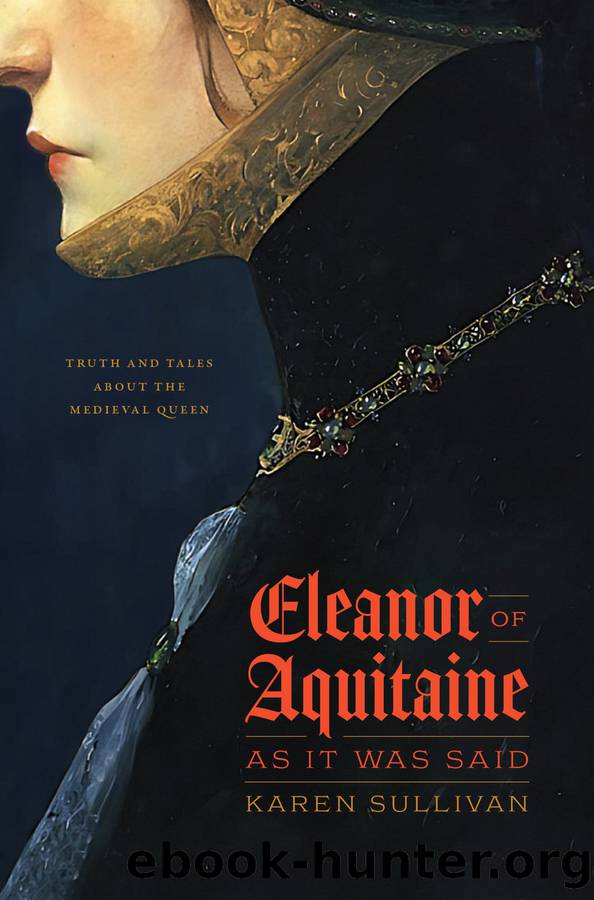Eleanor of Aquitaine, As It Was Said: Truth and Tales about the Medieval Queen by Karen Sullivan;

Author:Karen Sullivan; [Sullivan, Karen]
Language: eng
Format: epub
Tags: HIS000000 HISTORY / General, HIS037010 HISTORY / Europe / Medieval, HIS013000 HISTORY / Europe / France
Publisher: University of Chicago Press
Published: 2023-08-18T00:00:00+00:00
V
The Old Woman of Fontevraud
The Cloister and the World
In the last years of her life, Eleanor spent much of her time at the Abbey of Fontevraud, near Chinon. Founded almost a century beforehand, between 1099 and 1101, the abbey had become famous for the piety of its virgins. As at other monasteries, a nun would spend her days attending religious services; gathering regularly with her sisters to pray, sing hymns, and listen to psalms; and devoting her solitary hours to private orisons and reading. She would never venture outside the walls of this abbey or even interact with visitors inside the enclosure except under the most strictly regulated conditions. At the same time, Fontevraud became well known for its âconvertsâ (conversae) or âwidowsâ (viduae), onetime married women who also found refuge in its walls. While the virgin occupied herself exclusively with contemplative matters, the conversa not infrequently concerned herself with the active administration of the compound, especially in its dealings with the outside world. Because she typically had experience running a household or an estate prior to her entry into religion, only a conversa was eligible to lead the community. If elected abbess, she would travel to confer with Fontevraudâs priories, represent the order at councils, and visit potential donors. Most remarkably, she would wield power, not only over the nuns, but over the religious brothers who were brought in to serve the womenâs needs. Until its dissolution at the time of the French Revolution, Fontevraud constituted, not only the largest and most prosperous confederation of monasteries for women in Western Europe, but one where, as Voltaire remarked with astonishment, âOne sees the male sex . . . serve the female.â1 Once attached to this abbey, Eleanor was able to affiliate herself with a spiritual community, as was thought appropriate for women after a certain age, but one that respected womenâs authority.
When Eleanor began to spend significant amounts of time at Fontevraud, she was, in effect, living in two worlds. She was existing in historical time in the lands ruled, at least nominally, by her sons, with their ceaseless political tumult. She was employing her considerable skills and experience to ensure that Richard and then John preserved the power and wealth that was their due. Yet Eleanor was also existing âunder the aspect of eternityâ (sub specie aeternitatis) in an abbey governed by an abbess and given over to the daily opus dei. When she thought of Henry, their children, or any members of her family in these last years, she was thinking of them, not just as historical figures in the world, but as eternal figures, all of whom but John and young Eleanor had by this point migrated from this world. This late husband and these late sons and daughters, who once eagerly strove to accomplish their political ambitions in the secular world, were now quietly awaiting the end of time and the Resurrection of the Flesh it would bring in the hereafter. At that future moment, it
Download
This site does not store any files on its server. We only index and link to content provided by other sites. Please contact the content providers to delete copyright contents if any and email us, we'll remove relevant links or contents immediately.
| France | Germany |
| Great Britain | Greece |
| Italy | Rome |
| Russia | Spain & Portugal |
Fanny Burney by Claire Harman(26249)
Empire of the Sikhs by Patwant Singh(22774)
Out of India by Michael Foss(16695)
Leonardo da Vinci by Walter Isaacson(12810)
Small Great Things by Jodi Picoult(6691)
The Six Wives Of Henry VIII (WOMEN IN HISTORY) by Fraser Antonia(5241)
The Wind in My Hair by Masih Alinejad(4850)
The Crown by Robert Lacey(4578)
The Lonely City by Olivia Laing(4572)
A Higher Loyalty: Truth, Lies, and Leadership by James Comey(4558)
The Iron Duke by The Iron Duke(4126)
Millionaire: The Philanderer, Gambler, and Duelist Who Invented Modern Finance by Janet Gleeson(4108)
Sticky Fingers by Joe Hagan(3916)
Papillon (English) by Henri Charrière(3914)
Joan of Arc by Mary Gordon(3790)
Alive: The Story of the Andes Survivors by Piers Paul Read(3737)
Stalin by Stephen Kotkin(3730)
Aleister Crowley: The Biography by Tobias Churton(3429)
Ants Among Elephants by Sujatha Gidla(3282)
